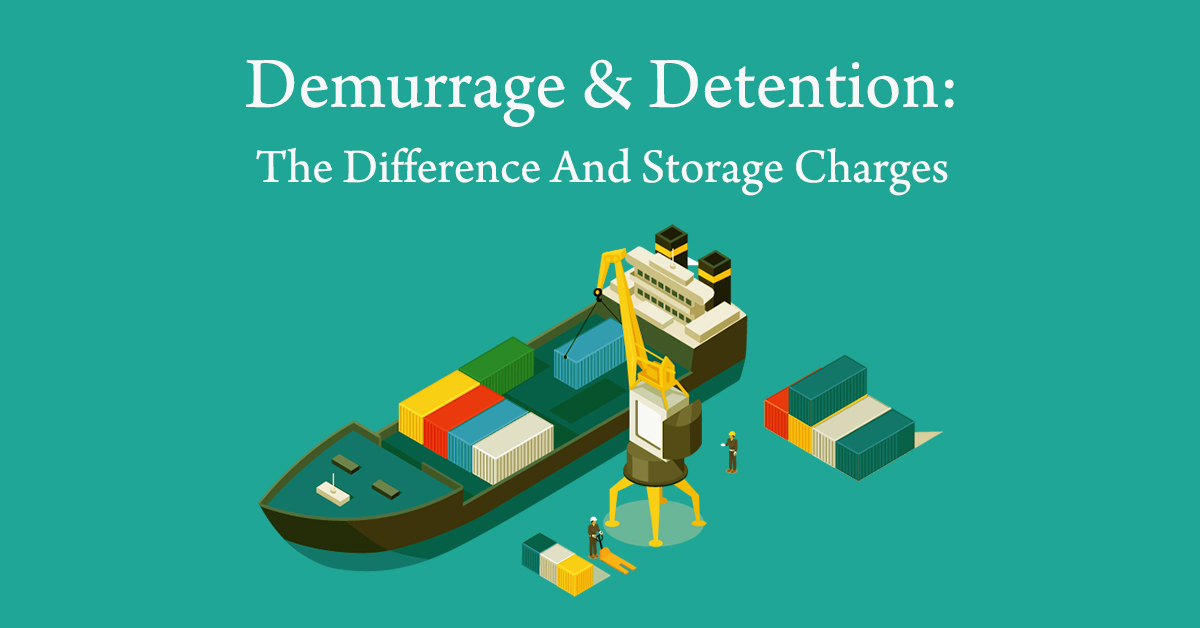Demurrage & Detention: The Difference And Storage Charges

Being unpunctual with the movement of containers may cause detention and incur demurrage charges. The charges will keep increasing once the number of free days is exceeded. Freight forwarders may find these per diem charges to be a burden but for shipping lines, they work well. They ensure that containers are used efficiently. These charges were rare a decade ago in international maritime trade but things have changed significantly. Today, detention and demurrage charges can increase to the extent that they exceed the value of the container.
Additional charges are not good for business. Knowing the detention v/s demurrage charges is advisable. This will help to avoid them.
What is detention?
When the container is unloaded from the vessel and is taken inland to the customer’s location from the port, the empty container must be returned back to the port. It must be returned to the empty container depot or from where it was brought.
If the consignee fails to return the container after discharging its contents within the limited period then the carrier will charge them. These are detention charges and are charged on a per day, per container basis.
Empty containers are taken by the consignee to where they can be loaded with merchandise. It is important to ensure the loading takes place within the specified period and the container reaches back at the port for sailing. Arriving late at the port may mean the container misses its sailing time and this can lead to detention charges.
What is demurrage?
Demurrage is a charge applied by the freight provider on the importer when they fail to take away their goods from the port after unloading. For a number of reasons the containers delivered at the port may remain there for an extended period. Generally, importers are provided with a number of “free days” by the freight provider. During that time they can store containers or goods at the terminal or port.
Occasionally, containers fail to get loaded onto the ship. Demurrage, on a per container basis may be applied in these cases.
Download Book Now

What are storage charges?
Storage charges are applied at the port for storing the goods at the warehouse or in its facilities when they are collected after the agreed timeframe. Generally, a certain number of days are allotted to the importer to collect the merchandise from the port. Failing to collect the merchandise within those days will incur storage charges. In certain cases, the storage charges will be paid by a customs broker or freight forwarder on behalf of the importer. The importer will then be billed by them.
Demurrage v/s detention: Understanding the differences
It is the buyer’s prerogative to decide how they plan to get charged in the case of any expected delays. Whether it be ‘detention’ or ‘demurrage’, it is advisable for the shipping line to manage the flow of goods effectively. Shipping lines may offer ‘free days’ while charging detention or demurrage.
- For exports
The port authorities provide a free period of 7-10 days to exporters to take empty containers from the terminal and return them to the port after they are loaded. If the container is delayed by a few days the port authorities will charge the exporter with detention charges on a per-day basis.
If the exporter brings loaded containers to the port for dispatch before the agreed dispatch date then demurrage may be charged. This means that if containers arrive three days before the agreed day demurrage will be charged for 3 days.
- For imports
Importers must collect the containers from the port and take them away. Failure to do so will lead to demurrage charges. Demurrage charges will be applied by the port authorities on the containers from midnight of the day from when the free period ends. Demurrage is charged on a per-day basis.
Similarly, detention charges will be applied to the importer if they fail to return the empty containers back once they have been taken away.
Importers may be charged detention or demurrage based on the given situation.
Detention and demurrage charges globally
US ports charge higher rates. At US ports, demurrage charges are between USD 165 – USD 275 for a container of 20 feet. Charges are less at European ports. Rates are lowering in the ports of the Middle East and Asia, and are the lowest in China.
Apart from detention and demurrage charges, there are some other charges that consignees must to deal with. When a container yard or port storage area is temporarily used to store containers, port storage charges may be incurred. These charges are calculated for containers from the moment they enter the storage area until the moment they leave.
The operational and maintenance costs of the port are covered by the port dues. These expenses are passed on to ships and boats for accessing different facilities at the port. Charges are applied in the form of different fees. Some are port dues, cargo dues and tonnage dues.
Tonnage dues are charged on the basis of the weight of the vessel. Each ship must carry a tonnage certificate provided by the authority. The certificate shows the net and gross tonnage based on the International Convention of Tonnage or ICTM for Measurement of Ships (1969).
The convention is supported by the International Maritime Organization (IMO) which is followed by participating countries. They agree to follow certain rules while calculating the tonnage of ships moving on international voyages.
In order to avoid different rules, these principles and rules are applied uniformly by all abiding countries. ‘Wharfage’ or ‘cargo dues’ are charged for moving the cargo on port and accessing other facilities.
How to avoid demurrage, detention, and storage charges?
The cost of imported goods can quickly increase when demurrage, detention and storage charges are applied. Therefore it is important to know exactly when the goods will arrive.
The customs broker must be alerted about the imminent arrival of the goods.
If possible, all the information related to the goods should be provided to the freight forwarder or customs broker.
The carrier should be well informed about the arrival of the container so that it can be collected within the agreed free days.
When the merchandise arrives, the containers should be quickly emptied and the empty containers returned to their location on the port. Failure to do so will incur detention charges unless and until the carrier empties the containers and returns them to the location from where they were collected.
Negotiate the charges
Detention and demurrage charges cannot be always controlled. However, there are some ways to avoid extra costs. Instead of accepting the initial quote, it is worthwhile to negotiate with the carriers or port officials. They may provide more free days. Port officials are more likely to respond to the requests of the companies with higher cargo volumes.
Summary
For importers and exporters, understanding detention v/s demurrage charges is advisable. It is important to know their meaning and how they can affect the whole budget. Knowing when they will be charged can enable importers and exporters to prepare themselves to take the necessary steps and avoid them.
Popular Post Like This
